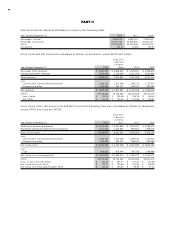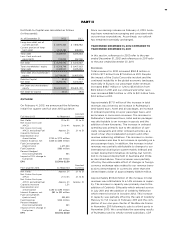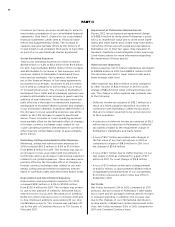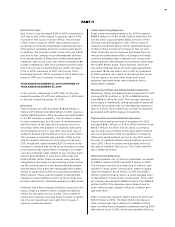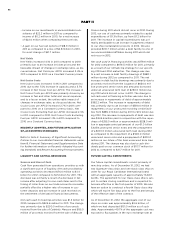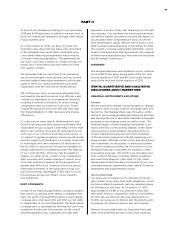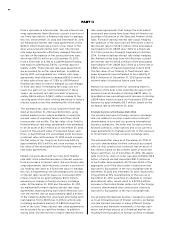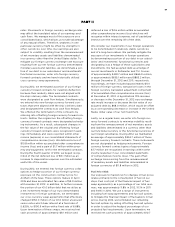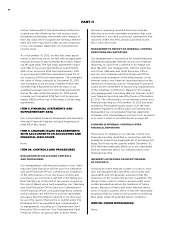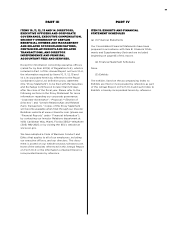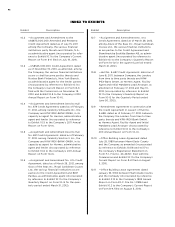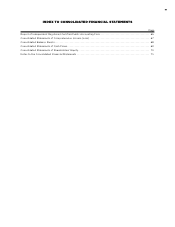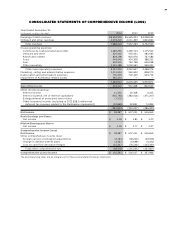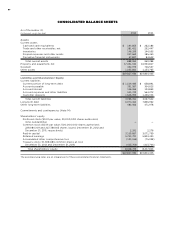Royal Caribbean Cruise Lines 2012 Annual Report Download - page 62
Download and view the complete annual report
Please find page 62 of the 2012 Royal Caribbean Cruise Lines annual report below. You can navigate through the pages in the report by either clicking on the pages listed below, or by using the keyword search tool below to find specific information within the annual report.
58
PART II
million. Subsequent to the termination, neither the
original nor the offsetting fuel call options were
designated as hedging instruments and changes in
their fair value were recognized in earnings immedi-
ately and were reported in other income (expense)
in our consolidated statements of comprehensive
income (loss).
As of December 31, 2012, we had fuel swap agree-
ments to pay fixed prices for fuel with an aggregate
notional amount of approximately $1.1 billion, matur-
ing through 2016. The fuel swap agreements repre-
sent 55% of our projected 2013 fuel requirements,
45% of our projected 2014 fuel requirements, 25%
of our projected 2015 fuel requirements and 7% of
our projected 2016 fuel requirements. The estimated
fair value of these contracts at December 31, 2012
was estimated to be an asset of $48.6 million. We
estimate that a hypothetical 10% increase in our
weighted-average fuel price from that experienced
during the year ended December 31, 2012 would
increase our forecasted 2013 fuel cost by approxi-
mately $35.8 million, net of the impact of fuel swap
agreements.
ITEM 8. FINANCIAL STATEMENTS AND
SUPPLEMENTARY DATA
Our Consolidated Financial Statements and Quarterly
Selected Financial Data are included beginning on
page 65 of this report.
ITEM 9. CHANGES IN AND DISAGREEMENTS
WITH ACCOUNTANTS ON ACCOUNTING AND
FINANCIAL DISCLOSURE
None.
ITEM 9A. CONTROLS AND PROCEDURES
EVALUATION OF DISCLOSURE CONTROLS
AND PROCEDURES
Our management, with the participation of our Chair-
man and Chief Executive Officer and Vice Chairman
and Chief Financial Officer, conducted an evaluation
of the effectiveness of our disclosure controls and
procedures, as such term is defined in Exchange Act
Rule 13a-15(e), as of the end of the period covered by
this report. Based upon such evaluation, our Chairman
and Chief Executive Officer and Vice Chairman and
Chief Financial Officer concluded that those controls
and procedures are effective to provide reasonable
assurance that information required to be disclosed
by us in the reports that we file or submit under the
Exchange Act is accumulated and communicated
to management, including our Chairman and Chief
Executive Officer and our Vice Chairman and Chief
Financial Officer, as appropriate, to allow timely
decisions regarding required disclosure and are
effective to provide reasonable assurance that such
information is recorded, processed, summarized and
reported within the time periods specified by the
SEC’s rules and forms.
MANAGEMENT’S REPORT ON INTERNAL CONTROL
OVER FINANCIAL REPORTING
Our management is responsible for establishing and
maintaining adequate internal control over financial
reporting, as such term is defined in Exchange Act
Rule 13a-15(f). Our management, with the participa-
tion of our Chairman and Chief Executive Officer
and our Vice Chairman and Chief Financial Officer,
conducted an evaluation of the effectiveness of our
internal control over financial reporting based on the
framework in Internal Control—Integrated Framework
issued by the Committee of Sponsoring Organizations
of the Treadway Commission. Based on this evalua-
tion, management concluded that our internal control
over financial reporting was effective as of December
31, 2012. The effectiveness of our internal control over
financial reporting as of December 31, 2012 has been
audited by PricewaterhouseCoopers LLP, the inde-
pendent registered certified public accounting firm
that audited our consolidated financial statements
included in this Annual Report on Form 10-K, as stated
in its report, which is included herein on page 66.
CHANGES IN INTERNAL CONTROLS OVER
FINANCIAL REPORTING
There were no changes in our internal control over
financial reporting identified in connection with the
evaluation required by paragraph (d) of Exchange Act
Rules 13a-15 during the quarter ended December 31,
2012 that have materially affected, or are reasonably
likely to materially affect, our internal control over
financial reporting.
INHERENT LIMITATIONS ON EFFECTIVENESS
OF CONTROLS
It should be noted that any system of controls, how-
ever well designed and operated, can provide only
reasonable, and not absolute, assurance that the
objectives of the system will be met. In addition, the
design of any control system is based in part upon
certain assumptions about the likelihood of future
events. Because of these and other inherent limita-
tions of control systems, there is only the reasonable
assurance that our controls will succeed in achieving
their goals under all potential future conditions.
ITEM 9B. OTHER INFORMATION
None.


